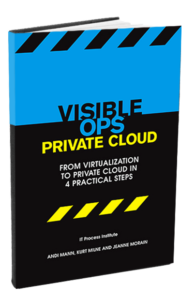Visible Ops Private Cloud
 Deploying a private cloud requires segmenting and managing a portion of the data center as a central pool of computing resources. The private cloud infrastructure is highly virtualized and, in many respects, similar to more static consolidate virtual server environments. With a private cloud, however, IT is built differently, IT is run differently, IT is governed differently, IT is sourced differently, and most importantly, IT is consumed differently.
Deploying a private cloud requires segmenting and managing a portion of the data center as a central pool of computing resources. The private cloud infrastructure is highly virtualized and, in many respects, similar to more static consolidate virtual server environments. With a private cloud, however, IT is built differently, IT is run differently, IT is governed differently, IT is sourced differently, and most importantly, IT is consumed differently.
The book is based on the study of enterprise IT organizations that have implemented private cloud solutions. Their private cloud projects range from mid-sized deployments to large-scale private clouds that encompass thousands of servers.
Who should read it?
Visible Ops Private Cloud was written with and created for enterprise IT executives and data center managers who are responsible for the success of private cloud initiatives. Whether you are trying to formulate an initial private cloud strategy or refine your current one, Visible Ops Private Cloud will help you get it right the first time.
By reading this book, you should be able to:
Understand the challenges faced and overcome by IT organizations that have successfully deployed private clouds.
Understand the key people, process, and technology competencies and focus areas necessary for a successful deployment.
Follow the four-phased deployment approach and implement a private cloud tailored to your business needs.
Gain acceptance of IaaS (rental model) for IT resources by all stakeholders, including internal IT, business users, and management
Synopsis
This book is based on the study of enterprise IT organizations that have implemented private cloud solutions including interviews with over 30 IT executives. It is also grounded by the authors’ more than 60 years of combined experience in systems management, virtualization, and IT process management.
Phase 1 – Cut through the cloud clutter: Plan and communicate objectives, manage initial proof of concept efforts, and develop competency road maps.
Phase 2 – Design services, not systems: Design business optimized cloud services, enable one-touch service ordering, and implement a repeatable approach for build and deploy.
Phase 3 – Orchestrate and optimize resources: Update monitoring and altering, deploy a policy engine to codify response, automate resource changes, and workload moves.
Phase 4 – Align and accelerate business results: Complete the transition to a resource rental model, reshape consumption behavior, and streamline response to changing business needs.
What Readers Are Saying
“It is a tour de force description for how to get there”
“A must read for every IT Pro who is interested in private cloud deployments”
“It is a tremendous resource for organizations looking to develop and deploy a private cloud”
“… addresses both the technical and human factors that maximize your chance of getting it right the first time.”
